The Optimum Duration for a Project Is at the Point Where:
Clock aspect is the briny and significant aspect in a web. Its primary object is to complete the project at an earliest to get faster actualization of benefits of the project.
Activities on critical path and sub-critical way needs especial attention either to complete the project as per schedule or to reduce the completion meter. To reduce the scheduled time, non-critical activities can be well-advised American Samoa potential pools of resources for diverting to critical or near hypercritical activities.
In about projects, it is desirable to cut down the total picture time, even if it leads to increase in cost. It is generally desired where cost considerations are unimportant or less important than completing the project in absolute marginal time e.g., defending team whole caboodle in emergency.
In general IT is achievable to foreshorten the envision duration by dynamic the resources allocated to it. The increase or decrease of the visualize continuance results in decrease or growth in the cost of the project. For this purpose, time and costs are analysed in a systematic way. This depth psychology also helps in determining optimum duration of the contrive.
For perusing the project meter and cost analysis, we shall fast talk about virtually project costs and meter-cost relationship.
Project Costs :
In that respect are two types of costs associated with a project:
(i) Direct costs:
It represents the expenditure which can be allocated to different activities in a send off, like men, material etc.
(II) Mealymouthed costs:
It represents the expenditure connected those items which are shared by more than one activity and cannot be forthwith allocated to individual activity of a project.
Indirect costs of a project are those expenditures which cannot be apportioned or clearly allocated to the individual activity. These include the expenditure related to the administration and establishment charges, budget items, supervision, loss of revenue etc.
Indirect cost rises with increased duration. Relationship betwixt indirect monetary value and project length is shown in Fig. 29.1. This kinship would be represented away a straight wrinkle, with a slope equal to daily viewgraph.
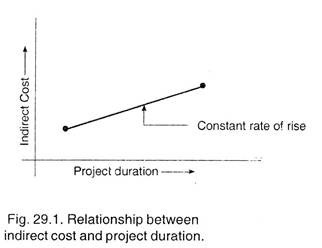
When thither is a loss of profits collectible to inability to meet the demand or some penalisation due to delay, a corresponding toll growth (known every bit outage loss), essential be added to the cost of overheads, as shown in the Figure. 29.2.
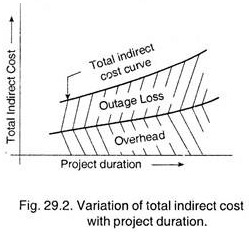
Total cost of a undertaking is the sum of the direct and the indirect costs. These costs are plotted in Fig. 29.3.
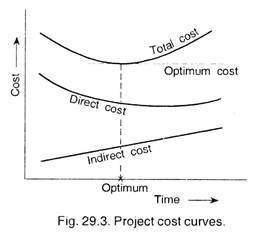
With the help of above curves, we can determine optimum duration, which is also referred as target duration. If the critical path is equal or shorter than this optimal duration, there is no need to reduce the network, i.e., crashing the continuance of any activity. If however, the critical path is longer than the project's optimum duration, and then there is need to reduce the continuance of some activities, so that the critical itinerary is equal to the optimal duration.
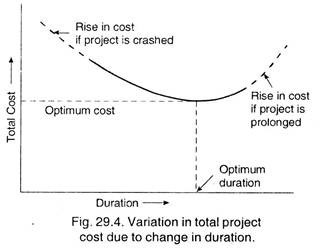
In order to empathise the effect of length on the complete cost of the project, Libyan Islamic Fighting Group. 29.4 is drawn.
These curves help the management to determine following aspects for attractive future decisions more or less the send off duration and resource allocation:
(а) Determinative the project duration, for which the cost is least, i.e., optimal continuance of the project at which the be is optimum.
(b) Determining the to the lowest degree cost of a reduction in project duration from a stipulated date. This is done when the stipulated go out is earlier than the optimum time for the send off.
(c) Determining the time-be-risk relationship. In this, endangerment Byzantine in eliminating any activity is calculated. This metre-cost chance helps the management to lease a determination about to the highest degree system solution, based on the circumstances and the objectives of a particular situation.
This shows that the network technique is an analytical tool for advisable planning, programing, monitoring and decision-making.
Crash Point and Normal Point :
Fig. 29.5 shows variation in the cost of an activity with time. The physique likewise indicates that there is scholarly point in time beyond which it volition representsemen probably expensive to try to shorten the time schedule of an activity.
It also indicates that lengthening of an activity more than a certain time dura matertion results in worthless price savings. First such point is "Crash Compass point" while second so much luff is titled "Normal Point", as shown in the Fig. 29.5.
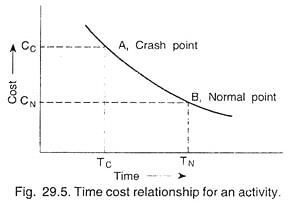
Cost Slope :
In actual do, we adopt the time-cost curve to be linear between doss down point A and Normal point B. The curve has shown in Common fig. 29.5 shows that, there is a change in cost for change in time. The full term 'cost-pitch' is outlined equally the "increase in the cost of the activity per unit decrease in the time".
Mathematically, we can say,
Be slope = Clank cost – Normal cost/Normal sentence – Crash time
In simple words, we can say that cost slope of an activity is the increase in cost of an activity by reduction the duration by one unit.
Conducting a clash programme usually result in an increase in cost of those activities that are constructed under the crash programme. In order to keep the number increase in price to a token, it is necessary to crash those activities which permit reduction in construction time at the to the lowest degree total increase in price. The reduction in time for a project can be achieved past reducing the continuance of indefinite or Sir Thomas More activities prevarication on the critical analysis path.
Crashing Procedure :
The cost gradient concept helps in determination lowest cost solution past sequential compressing the activities having lowest monetary value slope, i.e., having lowest incremental cost, on critical way.
Sometimes away bally one activeness, critical course is shifted; thus, at each shift of the life-threatening path, IT will be necessary to reckon the price-slopes of the activities on new critical way of life. Then the activity having the lowest cost gradient inevitably to constitute compressed on this inexperient grave path. This process is repeated until the project crash point is reached.
Procedure for crashing a send off is explained hereinafter:
(i) The ratio of increase in cost to decrease in fourth dimension for for each one activity that bathroom be crashed on the critical path is calculated and compared.
(ii) The activity having the lowest ratio is reduced to the next lower time value.
(iii) The critical path for the network is again calculated victimization the new time for the crashed activity.
(iv) Repeat tone (ii) and (iii) until the critical path is capable optimum project duration or equal to regular project duration.
Example 1:
For a network shown in Al-Jama'a al-Islamiyyah al-Muqatilah bi-Libya. 29.6, Normal sentence, Clank clock, Average cost and Crash costs are given in the table. Contract the network by crashing it to optimum value and calculate the optimum project price. Indirect price is given as Rs. 100 per day.
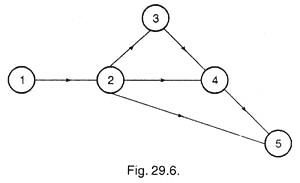
Solution:
By draft the network with normal duration, we get wind (from following figure) that critical path is 1-2-3-4-5.
The see duration is, therefore, equal to 18 days. On this course, Crash clock time = 13 years (from given data along evaluative route).

Normal cost and crash cost can now be calculated by adding values of all the activities, given in the postpone.
Normal price = Rs. 4100 and Crash cost = Rs. 4900.
To construct the network, in first stage we should identify those activities on critical paths, which have cost-slopes less than the indirect cost. For this purpose cost slopes are calculated hereafter
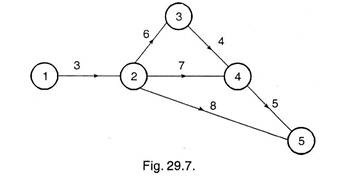

Critical path activities 2-3 and 4-5 have to the lowest degree price slopes. Therefore, these activities are first crashed and network is once again drawn (Refer Fig. 29.8).
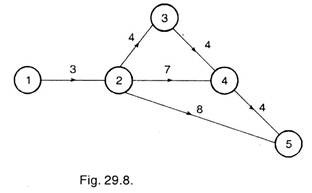
This electronic network shows that, later on blinking activities 2-3 by 2 days and 4-5 by 1 day, the critical path is same, i.e. 1-2-3-4-5 and cause 15 years duration.
Now in bit stage, the least cost slope in leftover activities is for activity 3-4 on the critical itinerary.
By crashing this activity, we see that two paths become overcritical way of life, 1-2-3-4-5 and 1-2-4-5 as shown in Fig. 29.9 at a lower place:
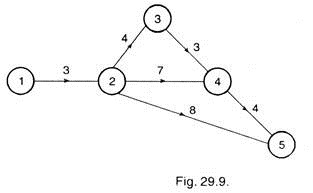
Now we see that after blooming activities 2-3, 4-5 and 3-4, there is no other activity on some the critical paths which have cost slopes less than digressive toll. This shows that this is the best network and thence optimum jut out duration is 14 days.
Total direct project cost for this optimum duration
= Direct cost for each activities on the web
= Cost on activities 1-2; – 2-3; 2-4; 2-5; 3-4; 4-5
= 300 + 520 + 2100 + 400 + 360 + 520 = Rs. 4200.
And indirect cost for 14 years @ Rs. 100 per day = Rs. 1400
Summate project cost after crashing = 4200 + 1400 = 5600.
Whereas tally cost with all natural activities was (i.e. without crashing)
= Sane cost + Indirect for 18 days = 4100 + 1800
= Rs. 5900.
Thus the optimum cost of the stick out is Rs. 5600. By crashing to optimum value, we could save Rs. 300. If we further crash the externalise beyond optimum evaluate, the project shall become costlier.
The Optimum Duration for a Project Is at the Point Where:
Source: https://www.businessmanagementideas.com/project-management/cost-model-crashing-of-network/6514
0 Response to "The Optimum Duration for a Project Is at the Point Where:"
Post a Comment